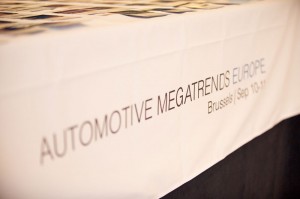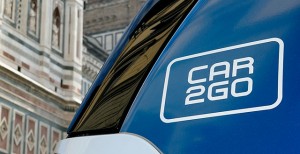“Smart everywhere” is the slogan that Benoit Schlumberger, Director Global Market & Industry Analysis at GM Europe, says lies at the heart of the OEM’s view of the future of automotive retail.
Schlumberger listed the top global megatrends identified by GM, which include ‘Green’, ‘Connected Living’, ‘Age and Living Longer’, ‘Global Luxury’, ‘Youth Attitudes’, ‘Partners in Design’, ‘Power of Women’, ‘Thoughtful Consumption’, and ‘Urban Mobility’.
 In his presentation in the Retail (R)evolution stream on the Passenger Car day at Automotive Megatrends Europe 2014 in Brussels, Schlumberger sought to position Europe within the global context of those GM megatrends.
In his presentation in the Retail (R)evolution stream on the Passenger Car day at Automotive Megatrends Europe 2014 in Brussels, Schlumberger sought to position Europe within the global context of those GM megatrends.
The automotive market in Western Europe, he said, has been and remains heavily impacted by a “lost generation” resulting from high youth unemployment. Furthermore, while the market in Western Europe shows no signs of significant growth, sales are set to increase in Central and Eastern Europe.
“Along with the mainstream brands being squeezed between value and luxury brands, there is an increasing fragmentation of the passenger car market,” said Schlumberger. Increasing fragmentation in model range and powertrain type means that dealers need to display a high number of models in their showroom – or at least be able to direct customers to so-called mega dealers.
All of this is coupled with the as-yet unproven notion that consumers do not need or want cars of their own. Focusing on the German market, Schlumberger produced data regarding vehicle ownership which shows that across Germany, 17.2% of the 40 million households do not own a car. In Berlin, the figure is much higher, at 41.2%.
Along with ‘smart everywhere’, Schlumberger used another slogan to represent the challenges facing the automotive industry: GUCCI. This stands for: gender; urbanisation; CO2; connected living; and intelligent cars. These trends are clear, and cropped up across the three conference streams at Megatrends Europe 2014.
As a result, new mobility concepts are arising, he said, and one in particular is that of car sharing. While inappropriate for rural areas, car sharing is an ideal solution for dense urban communities. It’s important to note, however, that the term car sharing is wide-reaching, he said, taking in national car sharing, corporate car sharing, peer-to-peer car sharing, dealer-based car sharing and urban car sharing schemes.
 This creates an opportunity for OEMs to get in on the business, too, and some already are. Car2go is Daimler’s programme, while BMW has a joint venture with Sixt called DriveNow; both of these schemes enable the OEMs to promote their brand to potential new customers, effectively using the vehicle rental as a test drive in one of their cars. “I cannot comment further,” said Schlumberger, “but there will be more schemes developing in this vein.” One challenge OEMs face is the fact that developing a car sharing scheme takes time; the schemes are most relevant in cities, but that’s where it’s most difficult to allocate dedicated space for parking, and if the cars are EVs, vehicle charging points, and so on.
This creates an opportunity for OEMs to get in on the business, too, and some already are. Car2go is Daimler’s programme, while BMW has a joint venture with Sixt called DriveNow; both of these schemes enable the OEMs to promote their brand to potential new customers, effectively using the vehicle rental as a test drive in one of their cars. “I cannot comment further,” said Schlumberger, “but there will be more schemes developing in this vein.” One challenge OEMs face is the fact that developing a car sharing scheme takes time; the schemes are most relevant in cities, but that’s where it’s most difficult to allocate dedicated space for parking, and if the cars are EVs, vehicle charging points, and so on.
Introducing another concept, Schlumberger asked whether cars currently fulfil all mobility needs. Most people, he said, get out of their car more stressed than when they got in – so what is a car for? With movement from A to B at the bottom of a pyramid, and relaxation at the top, Schlumberger illustrated a potential passage through mobility needs which also took in safety and comfort, speed, total cost of mobility, and entertainment. Somewhere along this scale, he said, there’s an opportunity to introduce autonomous driving.
Autonomous cars could overcome another question – that of what happens to vehicles when they are not being used. Most private cars are parked for the majority of each day, being driven for perhaps one hour a day. If we can maximise vehicle useage, and move to a point where those less-used cars are instead driven for five hours a day, then efficiency can be significantly improved.
Pursuing that theme further, Schlumberger suggested another opportunity for poorly-used vehicles, namely maximising the use of vans parked at weekends. Fleets could rent out their commercial vehicles when they are not being used, at once solving the problem of unused vehicles, and the lack of availability of vehicles needed by people who wish to make an impromptu weekend purchase.
In conclusion, Schlumberger suggested that long-term, OEM business models are likely to move from seeking market share – namely sales – to seeking a share of miles driven. Nonetheless, retail will continue. Key to OEM strategies are not only young people – who might never buy a car – but also the ageing population. What lies ahead is likely to involve an evolution for the ageing population, but for young people it will be a revolution.
Martin Kahl

